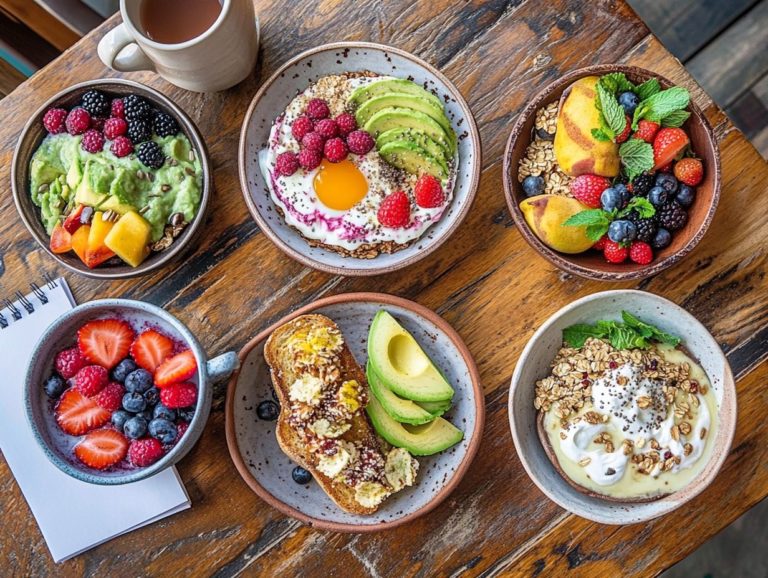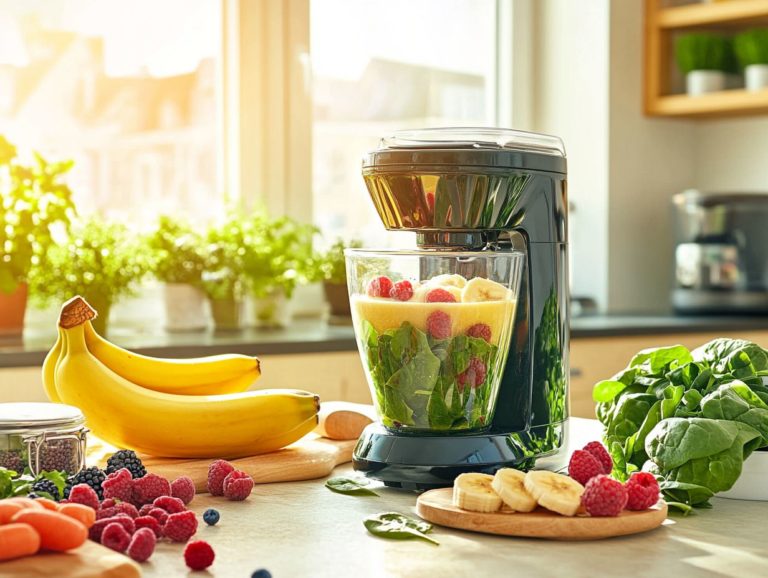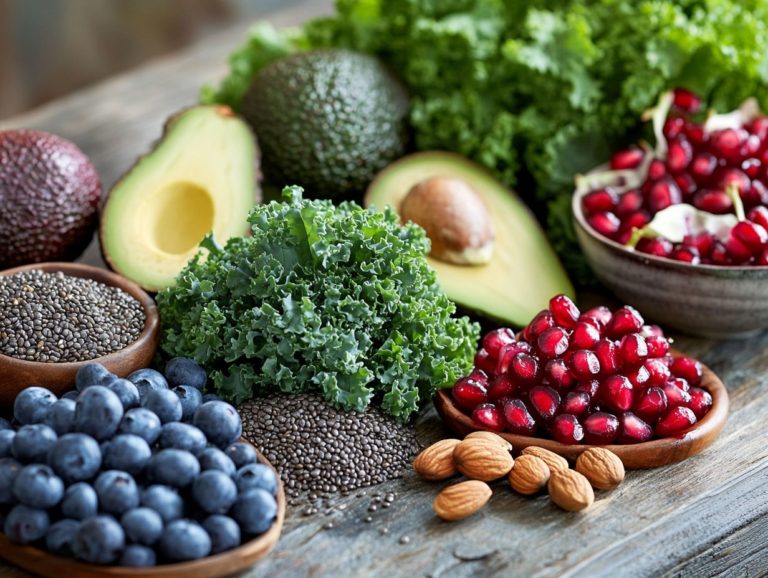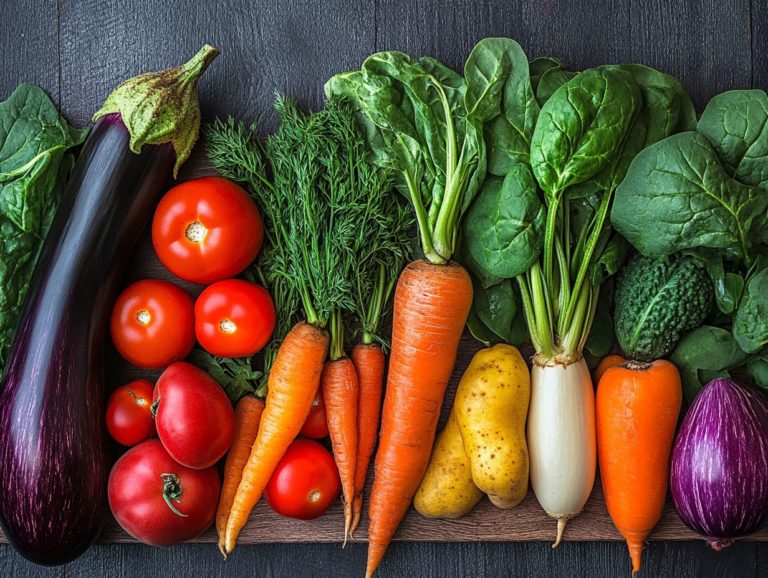5 Delicious Ways to Cook Vegetables
Vegetables often play the role of unsung heroes in your meals, brimming with nutrients and bursting with flavor.
Get ready to make vegetables the highlight of your meals! This article delves into five delightful cooking methods that will elevate your veggies to mouthwatering heights. From roasted medleys infused with aromatic herbs to a creamy vegetable curry, there s a culinary gem here for every palate.
You ll find invaluable tips on selecting, preparing, and transforming veggies into irresistible dishes, even for the pickiest of eaters.
Contents
Key Takeaways:
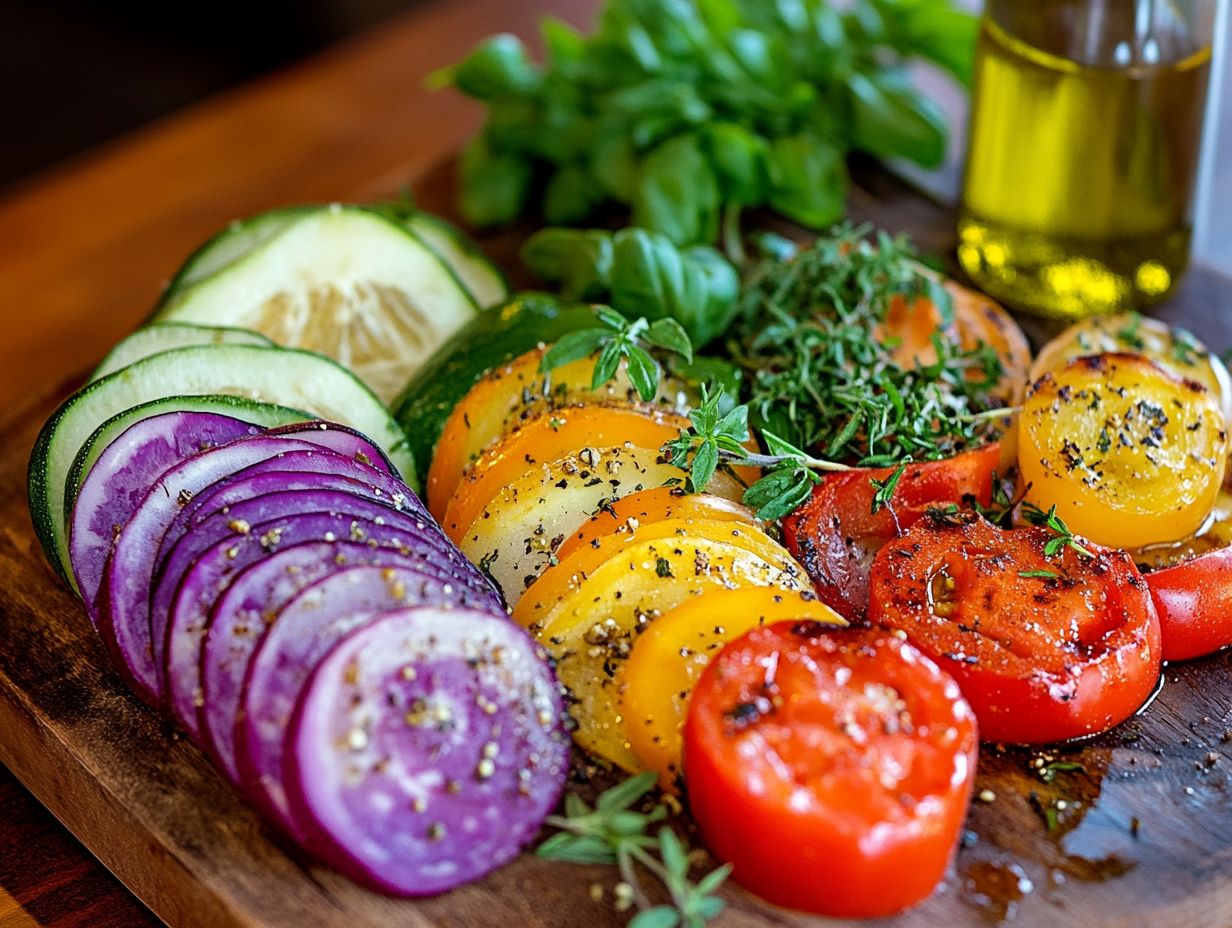
- Spice up your vegetable game by roasting them with herbs and spices.
- Add a burst of tangy flavor by grilling with a balsamic glaze.
- Stir-fry veggies with soy sauce for a quick Asian-inspired meal.
1. Roasted Vegetables with Herbs and Spices
Roasted vegetables seasoned with fresh herbs and garlic capture the essence of healthy sides. They deliver a delightful explosion of flavors while being incredibly easy to prepare.
To truly elevate the flavor, drizzle them with olive oil and a splash of lemon juice before cooking. This enhances their natural sweetness and promotes browning, resulting in a stunning golden-brown exterior.
For that perfect balance between tenderness and crispness, slice the vegetables into uniform pieces. Roast them at a high temperature to ensure they cook evenly and achieve that sought-after texture.
Popular combinations, like broccoli paired with carrots and Brussels sprouts, offer a vibrant presentation. As these different textures meld beautifully in the oven, you ll create a dish that s not just nutritious but visually appealing as well.
2. Grilled Vegetables with Balsamic Glaze
Grilled vegetables drizzled with balsamic glaze provide a delicious way to savor seasonal produce. This dish allows the natural sweetness of ingredients like zucchini, tomatoes, and bell peppers to truly shine.
Start by selecting fresh, vibrant vegetables. Cut them into uniform pieces to ensure even cooking. Techniques like using a grill basket or skewers are perfect for smaller veggies, keeping them from slipping through the grates.
Timing is key; for instance, zucchini typically takes about 3-4 minutes per side, while bell peppers benefit from a slightly longer cooking time of around 5-7 minutes.
You can also craft a balsamic glaze by simmering balsamic vinegar with a hint of honey. Finish with freshly chopped herbs like basil or rosemary for a delightful contrast to the rich char of the grilled vegetables.
3. Stir-Fried Vegetables with Soy Sauce
Stir-fried vegetables cooked with soy sauce offer a quick and nutritious option bursting with flavor. Stir-frying is a simple and effective cooking method, beautifully showcasing the vibrant colors and health benefits of fresh veggies.
The high heat of this method allows you to cook rapidly while preserving the crispness and essential vitamins in ingredients like spinach, broccoli, and edamame. Select a combination of these vegetables for a visually striking dish that is also brimming with nutrients.
To achieve that perfect stir-fry texture, preheat your pan until it s sizzling. This ensures each veggie stays tender-crisp without risking mushiness. Elevate the flavors by adding garlic and ginger, and finish with a splash of sesame oil for a delightful touch.
Don’t miss out on these delicious preparations! Try these methods today for a tasty veggie feast!
4. Vegetable Frittata with Cheese
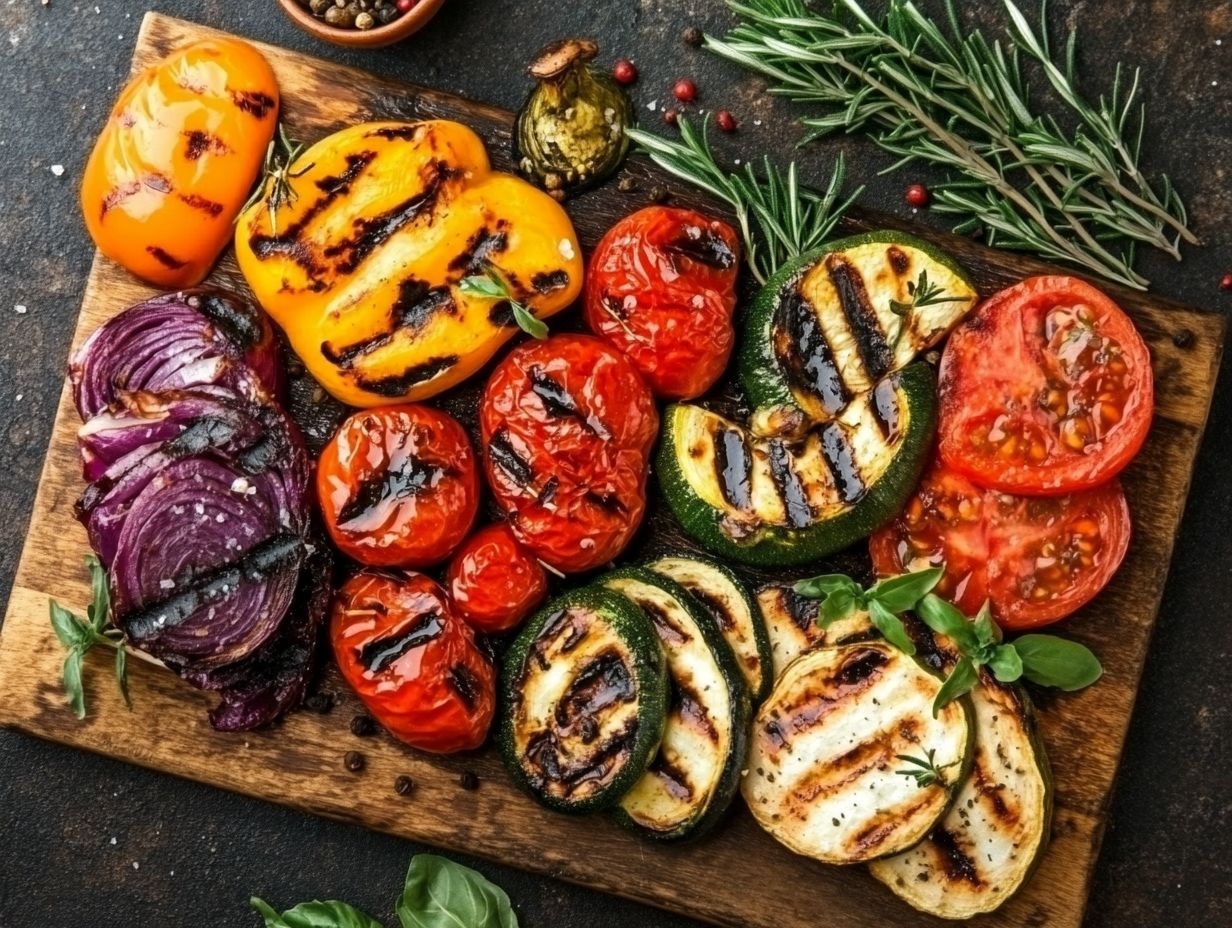
The vegetable frittata with cheese is more than just a meal. It s a delicious cooking experience that shows how fresh veggies and creamy textures can turn simple ingredients into a gourmet treat!
To craft this exquisite dish, start by choosing seasonal vegetables that are bursting with color and flavor. Spinach, tomatoes, and onions are timeless choices. Feel free to add bell peppers, zucchini, or even asparagus for more variety!
Selecting the right cheese is essential. Whether you prefer the sharpness of cheddar, the tang of feta, or the creaminess of goat cheese, each option brings its unique flair to the table, making every frittata an exciting adventure.
For that coveted fluffy texture, whisk those eggs with enthusiasm! Adding a splash of milk or cream enhances the experience. This dish is very adaptable; customize it with whatever ingredients you have in your kitchen or find at the local market!
5. Vegetable Curry with Coconut Milk
This hearty vegetable curry with coconut milk is comforting and wholesome. It’s perfect for anyone exploring a plant-based diet!
This versatile ingredient provides a rich, creamy base that harmonizes beautifully with spices like turmeric, cumin, and coriander, elevating the entire dish.
Consider incorporating vibrant vegetables such as cauliflower for delightful texture and sweet potatoes that bring natural sweetness and heartiness to the mix.
To balance flavors, saut aromatics like garlic and onion before adding the vegetables and coconut milk. This technique enhances the overall taste!
Finish the dish with a squeeze of lime or a sprinkle of fresh herbs for an extra flavor boost. Your creation will be well-rounded and satisfying!
How to Choose and Prepare Vegetables for Cooking
Choosing and preparing vegetables is an essential skill that impacts the flavor and nutrition of your meals. It blends knowledge of storage techniques, fresh ingredient selection, and effective cooking methods to maximize taste and texture.
When selecting fresh vegetables at the market, look for vibrant colors and firm textures these are signs of peak ripeness. Understanding seasonal availability is crucial as it enhances the flavor of your dishes and helps your budget!
Once you’ve picked your produce, proper storage is key. Leafy greens thrive with a bit of moisture, while root vegetables prefer a cool, dry environment.
To elevate the flavors, consider quick cooking techniques like saut ing or steaming. These methods preserve nutrients and maintain those bright, fresh tastes, making every dish enjoyable!
What Are the Health Benefits of Eating Vegetables?
Eating a variety of vegetables offers a wealth of health benefits, from better nutrition and effective weight management to a lower risk of chronic diseases. They are a crucial part of any healthy meal plan or plant-based diet!
Different vegetables provide unique nutrients. Leafy greens are packed with vitamin K, fantastic for bone health. Vibrant orange veggies like sweet potatoes are loaded with beta-carotene, great for eye health.
Don t overlook cruciferous vegetables, like broccoli and Brussels sprouts, which contain natural compounds that help your body detox.
By incorporating a colorful array of veggies into your meals, you’ll tap into antioxidants that combat free radicals, reduce inflammation, and boost your well-being.
This approach elevates your nutrient intake while enhancing the flavor, texture, and visual appeal of each dish. Make your diet more enjoyable and balanced!
Try out these recipes and share your favorite vegetable dishes with friends!
What Are Some Common Vegetables Used in Cooking?
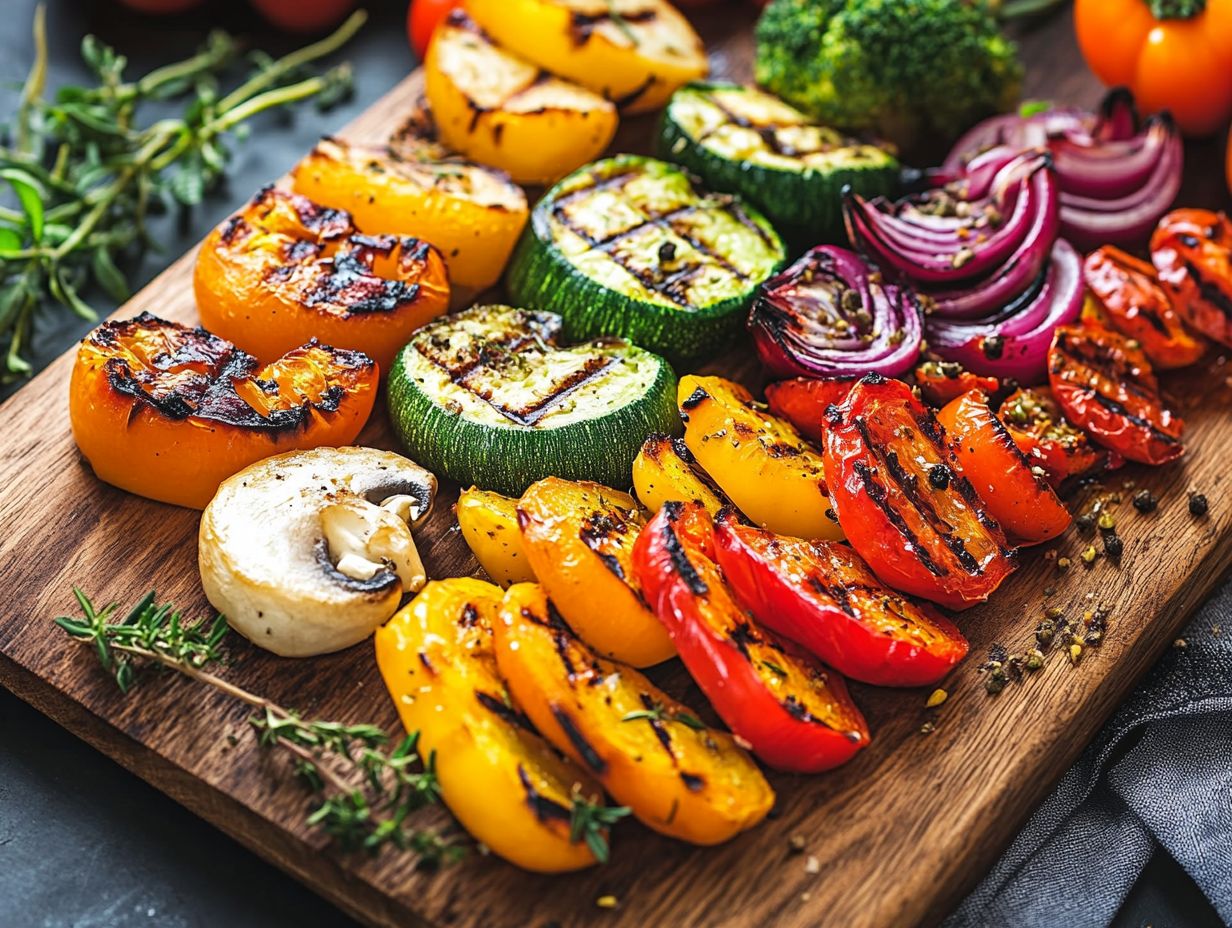
Common vegetables like broccoli, carrots, and cauliflower form the basis for many recipes. They add flavor and essential nutrients, making meals nutritious and satisfying.
You can steam, roast, or stir-fry these vegetables. Each cooking method allows their unique textures and tastes to shine. For example, lightly steaming broccoli maintains its crispness and bright color, maximizing vitamin retention.
Roasting carrots caramelizes their natural sugars. This transformation makes them a delightful addition to any plate. Meanwhile, cauliflower can be reinvented as a creamy puree or incorporated into hearty casseroles, showcasing versatility and health benefits.
By mastering various cooking techniques, you can easily add these vegetables to your meals, ensuring they are delicious and well-balanced.
How Can One Incorporate More Vegetables Into Their Diet?
Incorporating more vegetables into your diet can be accomplished through various delightful methods. You can craft veggie-packed recipes, experiment with innovative cooking methods, and integrate produce into meals in exciting ways.
One effective strategy is blending greens and fruits into smoothies. This not only enhances the nutritional profile but also cleverly disguises the strong flavors of vegetables for those who may be reluctant.
Creating vibrant salads can transform any meal into a colorful feast. By adding nuts, seeds, or a zesty dressing, you can elevate both taste and texture.
Consider using roasted or saut ed vegetables as toppings on pizzas, tacos, or grain bowls. This offers an easy yet delicious way to boost your daily servings.
With a touch of creativity, vegetables can become both appealing and central to a satisfying meal experience.
What Are Some Tips for Cooking Vegetables?
Cooking vegetables to perfection requires mastering various techniques and flavor enhancements. These can elevate even the simplest ingredients into extraordinary dishes that tantalize your taste buds.
By employing methods such as saut ing, roasting, and grilling, you can unlock the natural sweetness and unique textures of each vegetable.
For saut ing, a quick toss in a hot pan with high-quality olive oil and freshly minced garlic can dramatically elevate flavors. Roasting brings out caramelization; drizzling the vegetables with herbs like rosemary or thyme infuses them with deeper tastes.
Regarding grilling, timing is everything. You need to maintain that perfect crispness while ensuring tenderness. Keep a close eye on those cooking intervals. Experimenting with these techniques will guide you toward achieving a perfect balance of flavors and textures every time.
How Can One Make Vegetables More Appealing to Picky Eaters?
To make vegetables more appealing to picky eaters, present them creatively. Showcase their natural flavors while weaving them into familiar dishes that align with their tastes.
Consider preparing vibrant salads bursting with a rainbow of colors to pique their curiosity.
You can also sneak vegetables into their favorite recipes like adding spinach to beloved pasta dishes or pureeing sweet potatoes into muffins where they often go unnoticed.
Introducing a variety of dips and dressings can further elevate the experience, turning mealtime into a fun exploration of flavors.
Engaging them in the cooking process is equally important. When they actively participate in selecting and preparing meals, they re more likely to embrace the flavors, making mealtime an enjoyable adventure.
Frequently Asked Questions
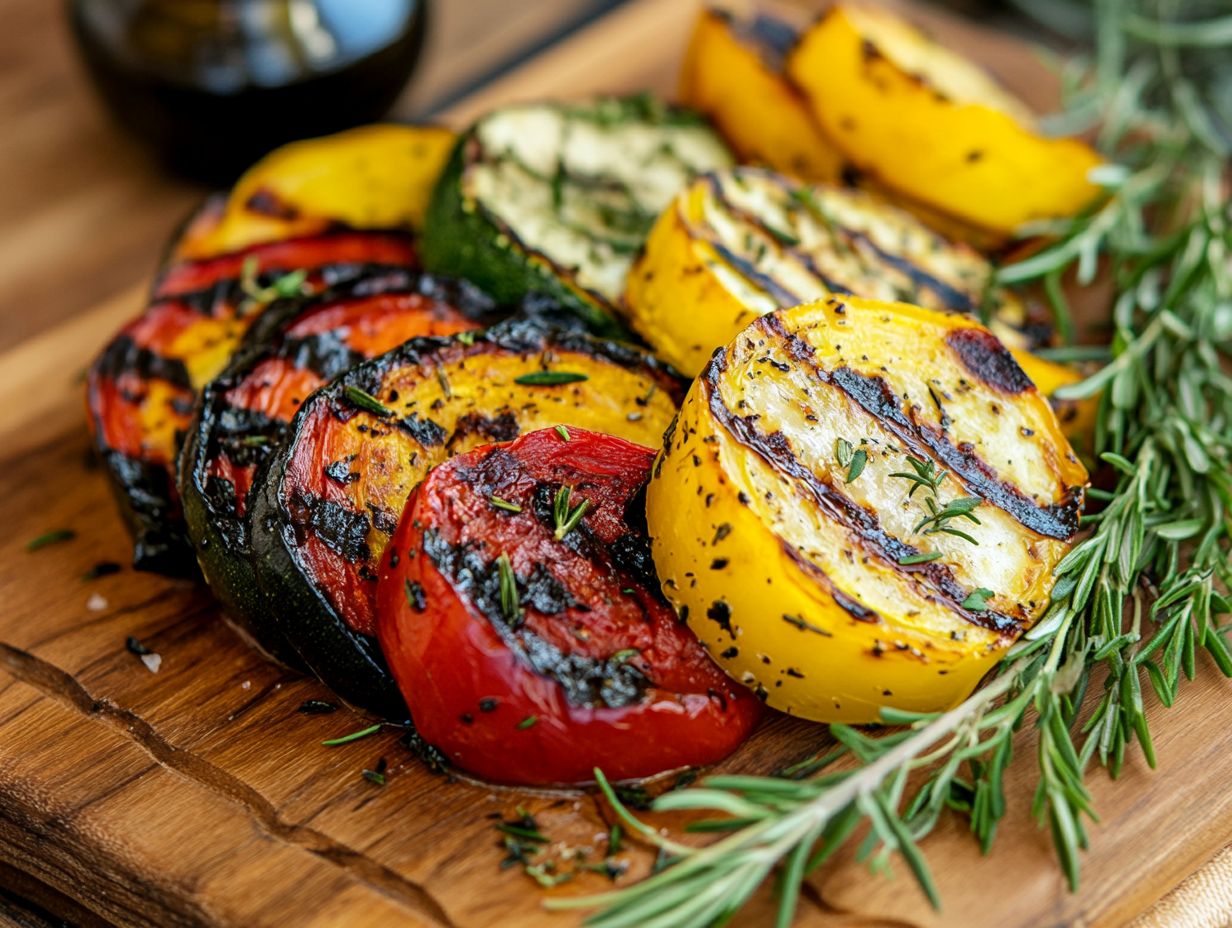
What are the 5 delicious ways to cook vegetables?
Here are five delicious ways to cook vegetables: grilling, roasting, sautéing, steaming, and stir-frying.
How does grilling enhance the flavor of vegetables?
Grilling vegetables brings out their natural sweetness and adds a smoky flavor. It also creates a nice char and crispy texture.
Can all types of vegetables be roasted?
Yes, you can roast many types of vegetables, including root vegetables and leafy greens.
Is steaming vegetables a healthy cooking method?
Absolutely! Steaming is one of the healthiest ways to cook vegetables because it doesn t use oils or fats.
This method also helps keep the nutrients intact.
How does stir-frying help preserve the nutrients in vegetables?
Stir-frying cooks vegetables quickly over high heat, which preserves nutrients.
It also adds a delightful crunch to your dish!
Are there any tips for saut ing vegetables?
Want to saut vegetables perfectly? Here are some tips!
Use a large pan to avoid overcrowding and cook on high heat.
Toss the vegetables often to prevent burning.


